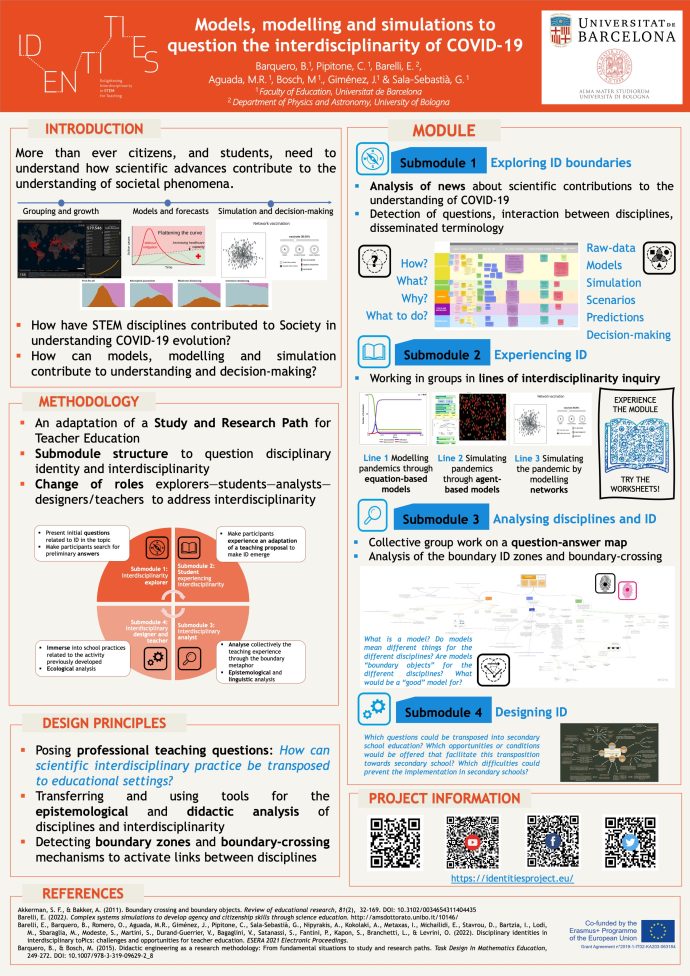Download the module’s lesson plan (pdf, editable format)
The topic of modelling the evolution of COVID-19 was chosen in part due to its intrusion into our daily lives at the beginning of 2020. An authentic example of STEM advanced interdisciplinarity is recognised as one major issue for society that required the collective effort of putting different disciplines to react in front of unexpected questions. Indeed, the COVID-19 pandemic has shown more than ever that students and, more in general, citizens need to understand how mathematics and scientific advances contribute to the understanding of societal phenomena. In addition, “the pandemic illustrates perfectly how the operation of science changes when questions of urgency, stakes, values, and uncertainty collide” (Saltelli et al., 2020). Specifically, it has emerged the need to explore what kind of knowledge can models and modelling provide, how we may interpret their predictions, and more in general, what contribution they provide to the understanding of such a complex issue.
The IDENTITIES approach for the design and implementation of the module is mainly evident in:
- the formulation of questions that are rich and relevant enough to be placed at the heart of pre-service teacher education programmes (such as the initial questions about “how have STEM disciplines contributed to the societal understanding of the evolution of COVID-19? How can this interdisciplinary practice be transposed to secondary schools?”)
- the facilitation, through the questions, of epistemological and didactic analysis tools of disciplinary and interdisciplinary knowledge at stake
- the detection of boundary objects and boundary-crossing mechanisms to switch on links between the disciplines and foster the analysis of interdisciplinary knowledge.
Introduction to the IDENTITIES approach to interdisciplinarity
Some videos to learn the basics of the frameworks, terminology, and tools on which the different activities of the module are built!
 Becoming explorers
Becoming explorers
Aims: First exploration of the topic-specific questions for interdisciplinarity, identification of the disciplines involved, detection of new terminology diffused to society, etc. The submodule finishes with the delimitation of possible lines of inquiry involving models and modelling as well as the interaction among different disciplines.
Activities: A selection of news collected during the months of pandemics is proposed to be analysed. Educators guide participants in a first analysis aiming to detect: e.g., relevant questions calling for disciplinary and interdisciplinary knowledge, answers provided by the scientific communities, and analysis of the terminology used.
Introduction to the submodule (pdf, editable format)


Guide for interdisciplinary analysis of the news (pdf, editable format)


List of news (pdf, editable format)
Template for the board for the analysis of news (pdf)
Group sharing: the students report the results of their analysis on the news (vertical analysis of the board)


Group discussion: the students comment on the evolution of the news throughout time (horizontal analysis of the board)





 Becoming students
Becoming students
Aims: The main goal of this submodule is to make participants carry out an unfamiliar interdisciplinary activity that could take place also in the classroom. The participants explore the issue of COVID-19 evolution from three different (but complementary) points of view: the real data processing, selection of variables, and their statistical analysis; the use of equation-based mathematical models for disease diffusion and the interpretation of the models’ coefficients, accordingly to the data; and the implementation of an agent-based simulation using methods inspired by statistical physics to evaluate different types of social intervention.
Activities: Educators ask participants to experience an interdisciplinary project, under the role of “students of interdisciplinarity”, about: (1) The complexity of delimiting the system to model: analysing data; (2) The role of the equation-based models: what can we consider a ‘good’ model? what are models for?; (3) Agent-based models and simulations: Simulating scenarios to help to make decisions about societal restrictions.
Introduction to the submodule (pdf, editable format)





Line 1: Analyse data to understand the evolution and formulate hypotheses (pdf, editable format)




Data of global confirmed cases (editable format)
Data of global deaths (editable format)
Line 2: The role of mathematical models in studying the evolution of the pandemic (pdf, editable format)



Data of first wave (editable format)
Line 3: Simulate scenarios to make decisions on social restrictions (pdf, editable format)




Simulation of an infectious disease outbreak – Basic phenomenon (zip folder with NetLogo file) by Xiang (2020a)
Simulation of an infectious disease outbreak – Social distancing (zip folder with NetLogo file) by Xiang (2020b)
Simulation of an infectious disease outbreak – Neighbour communities (zip folder with NetLogo file) by Xiang (2020c)
Simulation of an infectious disease outbreak – Changes in personal habits and intermittent perimeter closures (zip folder with NetLogo file and manual) by Alvarez and Rojas-Galeano (2020a, 2020b)
Simulation of an infectious disease outbreak – Population separated by age groups and geographically set (zip folder with NetLogo file) by Jimenez Romero (2020)
Group sharing





 Becoming analysts
Becoming analysts
Aims: Introduction, transference, and adoption of tools for the epistemological and linguistic analysis of interdisciplinarity and of disciplinary identities.
Activities: The participants become “interdisciplinarity analysts” since, in groups, carry out a meta-reflection on the previous activity on three different levels. The first level, using the tool of questions-answers maps (Winsløw et al., 2013), aims to sketch the process followed through the dialectics between the specific questions that the group has faced, and the answers obtained. The second level requires recognizing in the lines of inquiry examples of boundary objects. Finally, participants analyse the kind of interaction among disciplines (i.e. boundary-crossing mechanisms) that happens when boundaries are at stake and are eventually overcome.
Introduction to the submodule (pdf, editable format)


Sketching the questions-and-answers map


Template for the first branches of the questions-and-answers map (pdf)
Sharing of findings and experiences of the groups with sketching the questions-and-answers map


Boundary analysis of the contents of the module with the second guide for interdisciplinary analysis (pdf, editable format)






Collective discussion on the interdisciplinary analysis






 Becoming designers
Becoming designers
Aims: Introduction of elements of the ecological analysis of the modules’ activities to reflect on the possibilities of their transposition in schools.
Activities: In Submodule 4 some secondary school experiences linked to each line of inquiry are shared with participants. Then, they are expected to use the tools previously developed for interdisciplinary analysis to discuss the conditions to facilitate the implementation of interdisciplinary activities in real classrooms, as well as the constraints hindering the chances for interdisciplinarity to happen.
Collective discussion on the didactical transposition of the activities experienced in the module (pdf, editable format)


Download the module’s lesson plan (pdf, editable format)

